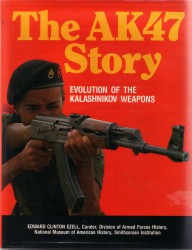 |
Kalashnikov, Part
2:
Soviet Political Economy and the Design Evolution of the Kalashnikov Avtomat |
 |
|
|
|
|
Firearms Technical Trivia, March 2001:
 |
Kalashnikov, Part
2:
Soviet Political Economy and the Design Evolution of the Kalashnikov Avtomat |
 |
BACKGROUND
The production model of Mikhail
Timofeyevich Kalashnikov's avtomat (assault rifle) had three distinct variants.
The first model AK-47 had a receiver assembly made from a combination of
a stamped sheet steel body and and machined steel inserts. The machined
steel insert at the front of the receiver into which the barrel was screwed,
and the stamped sheet metal rear assembly were attached to the stamped
steel receiver body using a combination of rivets and welds. Welded
to the receiver's bottom were both a pistol grip base and a trigger guard.
The first model AK-47 also had the upper edges of the receiver folded inwards
so as to form the guide rails for the reciprocating bolt carrier.
The beauty of the original AK-47 design was that it was engineered for manufacture on sheet metal punch- press machinery. The Russians, like the Germans, the British, and the Americans, had experienced severe shortages of raw materials, machine tools, and skilled laborers during the Second World War. As a result of these shortages, an intensive effort was made to design weapons and systems that could be made using the sheet metal stamping process. The technology itself was not new; it had been in use by the automotive industry for many years. The innovation came in applying this technology to the manufacture of weapons. The payoffs were potentially huge - by making the paradigm shift from components milled from solid steel bar stock to ones stamped out in large presses, the bulk of the effort was moved from the manufacture of finished components to the creation of the dies used to stamp out the parts.
The German World War Two experience is particularly illustrative of this point. The production of the Flak 38 20mm anti- aircraft cannon is an excellent example. Production engineers at DWM found that by making the receiver from stampings, they could reduce their raw material requirements from 99 pounds to 18.7 pounds, man hour requirements were reduced seventy percent, and almost two hundred machine tools dedicated to the receiver's manufacture were freed up for other critical manufacturing requirements. The Soviet experience during the war highlighted this critical need to shift production capacity away from small arms to other critical areas. At the outset of the war, that portion of the Soviet arms industry engaged in the production of small arms and artillery was the best prepared for the demands placed upon it by the conflict. Other segments of the industry were not in nearly so good a position. The central economic planners had not given the same attention to those industries specialized for the manufacture of armored vehicles or aircraft. As a result, the production of rifles and machine guns was optimized in 1942, and deliveries of these items to the military proceeded steadily in 1943 and 1944. However, in the other areas of the Soviet defense industry, there was a severe shortage of machine tools and skilled workers. While machine tools ordered abroad in 1939 and 1941, and deliveries of American tooling under Lend-Lease aided significantly, most of this capacity did not come on line until very late in the war. The Soviet economic leadership was forced to search for a technological means to overcome the shortage of critical production equipment. Sheet metal stamping technology, when applied to small arms, made it possible to reduce the need for certain critical machine tools and allow the redistribution of existing production capacity.
The Germans had come to the realization
that the stamped metal assemblies were most efficient when they were applied
to entirely new designs intended to take advantage of the technology.
While components of older designs could be made out of stampings and pressings,
this often led to problems where interchangeability with the original machined
components was required. There was also an ingrained prejudice on
the part of the users. While the stamped and welded components were
often more durable than their machined counterparts, they were usually
not as aesthetically pleasing. The prejudice was entirely unfounded
- the stamped metal components were in no way lower in quality or less
reliable, as can be attested to by the sterling performance records of
the MP-40, the MG-42, and the StG44, all of which made extensive use of
stamped and welded components. The most well known of Soviet wartime
weapons that made use of sheet metal stampings were the 7.62x25mm Pistolet
Pulemet Shpagina (PPSh41) and Pistolet Pulemet Sudayeva (PPS43)
submachineguns. However, the design of the Degtyarev DP light machinegun
also included significant usage of the stamped components. The DP,
the PPSh41, and the PPS43 racked up impressive service records despite
being made with extreme speed and with little attention to external finish.
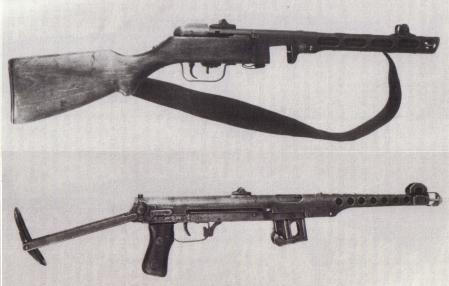
PPSh41, top, and PPS43, bottom Image Credit: Ezell, Edward Clinton, The AK47 Story, Stackpole Books, Harrisburg, Pennsylvania, 1988, Page 129 |
A comparison between the PPSh41 and the PPS43 demonstrates the long strides being taken by the Soviets during the war in the application of sheet metal pressings to weapons manufacture during the war. The PPSh41 was a significant improvement over its predecessors, the PPD34/38 and PPD40 (both Degtyarev designs). The PPSh used only eighty-seven components as opposed to the ninety-five for the PPD's. The real improvement was noted in the fact that it took only 7.3 hours of machining time to construct a PPSh41 as opposed to 13.7 for the PPD. The PPSh41's receiver and barrel jacket were stamped from cold rolled steel that was subsequently arc or spot welded as necessary. The PPD had seventy-two components machined by traditional methods, sixteen stamped from cold |
The PPS43 cut the machining time by more than half - 2.7 hours per gun as opposed to the PPSh41's 7.3. The PPS43 required only 13.7 pounds of raw steel, the PPSh41 had needed 30.6; indeed, the production of the Sudayev gun over the PPSh41 saved more than a thousand tons of steel per month, and decreased the number of workers needed to produce an equivalent number of submachineguns by more than fifty-five percent. By moving to the PPS43, a gun made almost entirely from stamped sheet metal, the Armament Commissariat was able to increase monthly submachine gun production from 135,000 to 350,000 guns.
THE AK-47
TAKES SHAPE
Russian sources are unclear as to
the decision making process that made the use of stamped sheet metal a
requirement of the AK-47 production plan. It is likely that the production
engineers with whom Kalashnikov worked, themselves products of the wartime
resource debacle, were the driving force behind the decision to manufacture
the rifle using the stamped sheet metal concept. Indeed, Soviet economists
and technologists trying to rebuild the nation's factories and production
capacity in the wake of the Second World War were looking for any technological
shortcuts that would enable new small arms, tanks, artillery, and aircraft
to be rapidly produced without embarking on new and expensive machine tool
building programs. Such programs would have required the services
of the most skilled of laborers in the Soviet labor force, and forced the
nation to spend rubles the war-torn economy simply didn't have.
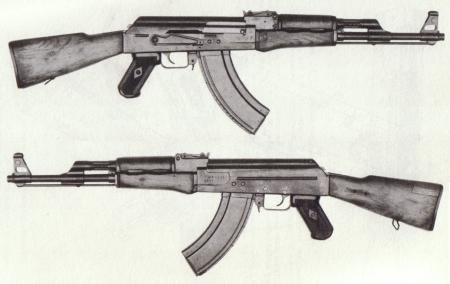
First Model AK-47 Image Credit: Ezell, Edward Clinton, The AK47 Story, Stackpole Books, Harrisburg, Pennsylvania, 1988, Page 131 |
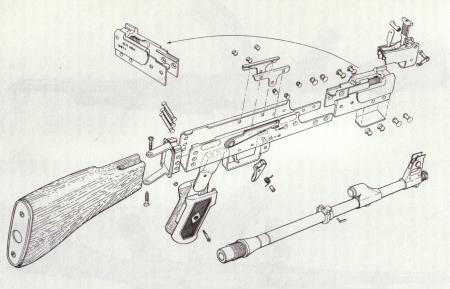
First Model AK-47, Exploded View Image Credit: Ezell, Edward Clinton, The AK47 Story, Stackpole Books, Harrisburg, Pennsylvania, 1988, Page 132 |
SECOND AND THIRD MODEL AK-47'S
|
Second Model AK-47, Exploded View Image Credit: Ezell, Edward Clinton, The AK47 Story, Stackpole Books, Harrisburg, Pennsylvania, 1988, Page 139 |
|
Third Model AK-47 Image Credit: Ezell, Edward Clinton, The AK47 Story, Stackpole Books, Harrisburg, Pennsylvania, 1988, Page 146 |
The more things change, the more they stay the same. The AKM was, in effect, a reintroduction of the first model of the AK-47, only with an "improved" type of sheet metal receiver assembly. The changes in the Kalashnikov design are an interesting testament to the evolution of the postwar Soviet defense industrial complex. In the ten years following World War Two, an immense amount of funding was pumped into the Soviet defense infrastructure, and its technological base grew strong, reflecting this support. By the mid-1950's, |
AVTOMAT KALASHNIKOVA MODERNIZIROVANNIY (AKM)
| The introduction of the AKM in 1959, and the return to a stamped receiver, provides almost as fertile a ground for speculation as the shift from the original sheet steel receiver to the machined receiver. In any event, there were some significant deign improvements embodied in the AKM. By reverting to sheet-metal fabrication production techniques, the AKM weighed significantly less than the AK-47 (6.92 versus 9.48 pounds). The AKM also had a new cluster of components added to the trigger assembly that serve as both a rate of fire reducer and a mechanism to eliminate "bolt bounce" (i.e., the prevention of misfires due to the failure of the bolt to lock during automatic fire). The Soviet service manual describes these components as a "hammer delay," and states that: "The hammer delay serves to delay movement of the hammer forward so as to improve the accuracy of fire during the conduct of automatic fire." The AKM is also more accurate than the AK-47, and the sights were recalibrated for a maximum range setting of 1,000 meters instead of the 800 of the AK-47. The AKM can be recognized by its sheet-metal receiver with indentations on the sides of the magazine opening (these "dimples" serve as guides for the magazine when it is inserted into the opening), the raised grasping rails on the forearm, the corrugations on the receiver cover, the absence of gas vent holes in the gas tube assembly, and a small compensator. |
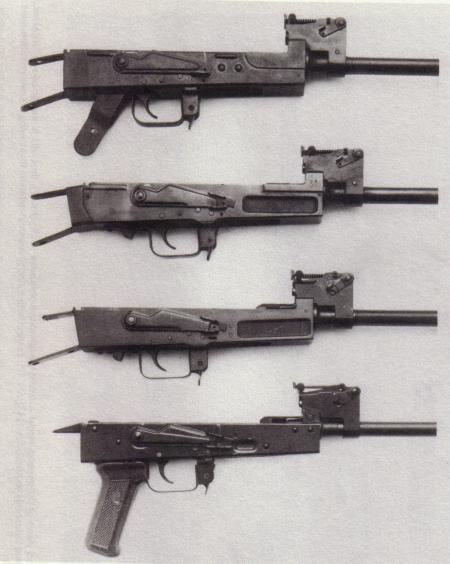
AK Receiver Comparison. From Top: First Model AK-47, Second Model AK-47, Third Model AK-47, AKM Image Credit: Ezell, Edward Clinton, The AK47 Story, Stackpole Books, Harrisburg, Pennsylvania, 1988, Page 148 |
CONCLUSION
Aficionados of and those familiar
with the developmental histories of western military weapons are well acquainted
with how issues of politics, national and personal ego, and economic realities
often exercise greater influence the development of military small arms
than operational or engineering concerns. The British adoption of
the FAL over the EM-2 (and later the L85A1 over the M16), the US adoption
of the M14 and later the M16, and even NATO standardization on the 7.62mm
cartridge at the insistence of US Colonel Rene Studler are all stories
evidencing this trend. What is surprising to many is that despite
having a centralized economy and an autocratic government that made virtually
unlimited funds available for the development of military hardware, the
Soviet Union fell victim to these same vagaries. What is even more
surprising is that in spite of these "non technical hurdles" the Soviets
managed to field the finest infantry rifle of the twentieth century.
Note: Data for this month's trivia page was gathered from:
Ezell, Edward Clinton, The AK47 Story, Stackpole Books (Harrisburg, Pennsylvania, 1986) ISBN 0-8117-2247-3
The AK47
Story is
available from IDSA Books. Click on the image to order:
